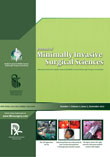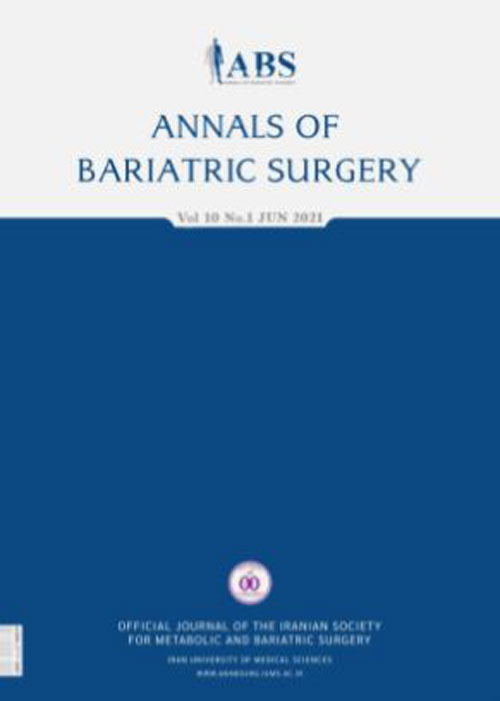فهرست مطالب

Annals of Bariatric Surgery
Volume:5 Issue: 2, Spring 2016
- تاریخ انتشار: 1395/03/05
- تعداد عناوین: 8
-
-
Page 1Background
Preliminary studies have indicated advantages of mesh fixation using fibrin glue in TAPP compared with tack fixation..
ObjectivesWe report the results of a prospective experience in fixing mesh during TAPP with absorbable tacks..
Patients andMethods50 consecutive men (who had bilateral inguinal hernia) were enrolled and followed up for at least 1 year. The primary measured outcome was pain experienced in day 1 of post-op. The secondary outcomes measured were postoperative scores of pain at rest, discomfort, and fatigue, foreign-body sensation, and hernia recurrence after 12 months. The outcomes were measured using a visual analogue scale, a verbal rating scale and numerical rating scales. A comparison was done within a historical group with the same demographic and hernia characteristics where the meshes have been fixed with fibrin glue..
ResultsThe group of tacks TAPP showed good results concerning the level of pain, fatigue and foreign body sensation comparable with those of the historical group. There were significant differences concerning the length of surgery where absorbable tacks performed better. Regarding cost of surgery, the fibrin glue showed effective results..
ConclusionsThe use of absorbable tacks during TAPP confers significant benefit regarding the operating time, however it is a disadvantage due to the cost when compared with fibrin glue..
Keywords: Minimally Invasive Surgery, General Surgery, Instruments, Laparoscopic Instruments -
Page 2Context: Laparoscopic approach with its several techniques has become the standard method for cholecystectomy over the past decades. As technical instruments have improved and varied, the interest in endoscopic surgery has turned towards minimal invasive single site access surgery with fewer instruments, thus resulting in minimal pain, minimal scarring and better cosmesis..
Evidence Acquisition: A systematic literature searching of databases MEDLINE, EMBASE, and Google Scholar was done from 1982 and updated in December 2015. Search terms were cholecystectomy, laparoscopic cholecystectomy, four port laparoscopic cholecystectomy, single-incision laparoscopic surgery..ResultsFour-port laparoscopic cholecystectomy was accepted as the gold standard in the treatment of patients with cholelithiasis before millennium. Thereafter, two-port laparoscopic cholecystectomy was reported as a novel, safe and rapid method of gallbladder removal in consecutive reports. Single-site laparoscopic cholecystectomy with non-conventional multi-channel port method was first introduced as an alternative to the standard multi-port laparoscopic cholecystectomy in adult patients in the last decade. Success rates of performing conventional four-port laparoscopic cholecystectomy were ranging from 93% to 100% and single site laparoscopic cholecystectomy was ranging from 84% to 100%..ConclusionsCurrently, it has been widely accepted that laparoscopic cholecystectomy is the gold standard for cholecystectomy. Although single site laparoscopic cholecystectomy is becoming more popular with the recent advancements, conventional multiport laparoscopic cholecystectomy is being widely used as the primary treatment modality for the gallbladder removal..Keywords: Cholecystectomy, Minimal Invasive Surgery, Laparoscopic Cholecystectomy, Single Site Access Surgery, Single Site Laparoscopic Cholecystectomy -
Page 3IntroductionEndoscopic submucosal dissection (ESD) of large tumors of the rectum is particularly challenging using colonoscopy or with laparoscopic instruments. More recently robotic assisted technique has been described..Case PresentationWe describe the first reported case of robotic transanal endoscopic submucosal dissection (RTESD) in Australia for a large circumferential laterally spreading tumor of the rectum using the da Vinci® Si system with the patient in the prone position. The case took 145 minutes and the authors found good manoeuvrability due to the intuitive nature of the robots endowristed miniaturised graspers. The prone position facilitated robot docking and reduced the external robotic arm clashing. This procedure was safely performed and the patient was discharged the following day. Colonoscopic follow up to one year revealed no recurrence of disease..ConclusionsRTESD in the prone position is safe and presents a feasible alternative for management of large rectal tumors. We also anticipate the technique to further improve with the advancement of robotic technology..Keywords: Robotic Transanal Endoscopic Submucosal Dissection, Large Rectal Tumor
-
Page 4Context: The human Nucleus Accumbens (NA) constitutes nowadays a target of deep brain stimulation (DBS) for selected patients mainly suffering from some psychiatric disorders. Mavridis Area (MA) of the human brain is the most reliable stereotactically standard part of the NA, regardless of side or gender. Primary purpose of this review article was to discuss the MA as a stereotactic microanatomic target for NA DBS application, emphasizing on technical aspects of targeting the MA..
Evidence Acquisition: A detailed search of the current literature regarding MA was applied. The critically reviewed literature was then used to discuss the MA as a stereotactic microanatomic target for NA DBS application, emphasizing on technical aspects of targeting the MA. The suggestion of future research directions was also aimed..ResultsFollowing the currently used trajectory through the anterior limb of the internal capsule (ALIC) in combination with the principles of the port model, a DBS electrode placement within the NA, targeting the MA, is feasible. MA could be the target area of one, only, of the electrode contacts, preferably contact 1 or 2. It could be also the target area for contact 0 in ALIC DBS and even the target for a combined NA-ALIC DBS. MA is the first and most representative example of the evolution of stereotactic anatomy into stereotactic microanatomy, in order to serve the development of the field of stereotactic microneurosurgery..ConclusionsMA is nowadays the most accurate stereotactic anatomic guide for targeting the human NA. It is a representative example of how stereotactic microanatomy could serve the development of stereotactic microneurosurgery. Following the currently used trajectory through the ALIC, a DBS electrode placement within the NA, targeting the MA, is feasible, allowing either NA or ALIC stimulation. Simultaneous stimulation of the NA and ALIC is also possible with this application..Keywords: Deep Brain Stimulation, Mavridi's Area, Nucleus Accumbens, Stereotactic Microanatomy, Stereotactic Microneurosurgery -
Page 5BackgroundDespite the reported advantages of laparoscopic appendectomy (LA), an ongoing debate exists about a possible increase in postoperative infectious complication rates. The analyses of risk factors associated with surgical site infections (SSIs) after LA, have been limited..
Patients andMethodsOne hundred twenty laparoscopic appendectomies performed over one year, were included in this retrospective study. The patients were divided into 2 group; group A was the one in which LA was done with using reusable retrieval bag and group B without using that. Demographic details, operative time, hospital stay and infective postoperative complications were recorded..ResultsThis patient groups were selected to be similar in both groups A and B in form of appendicitis types. Each group included 27 (45%) acute catarrhal appendicitis, 20 (33.3%) suppurative appendicitis and 13 (21.7%) perforated appendicitis, P = 1.0. The median patients ages were 21 years (range, 16 to 49) in group A and 25 years (range, 18 to 56) in group B, P = 0.053. Group A included 60 patients (35 males and 25 females) and group B 60 patients (32 males and 28 females), P = 0.071. Mean operative time in group A was 55.7 minutes and in group B was 57 minutes, P = 0.0231. Superficial wound infections were recorded in one patient (1.7%) in group A and in 8 patients (13.3%) in group B, P = 0.007. Intra-abdominal abscess formation was a complicated outcome in 2 patients (3.3%) of group B, P = 0.005. Mean hospital stay was 1.6 days in group A and 2.7 days in group B, P = 0.05..ConclusionsSurgical wound infections are less common by using reusable retrieval bag during laparoscopic appendectomy procedure. Also, using reusable retrieval bag has less cost..Keywords: Surgical Wound Infection, Laparoscopic Appendectomy, Retrieval Bag -
Page 7BackgroundConsidering the importance of providing vitamins and minerals in body health, it obviously seems to be necessary to assess the deficiencies of these nutrients in obese patients..ObjectivesThe present study aimed to evaluate the level of hemoglobin, ferritin, and vitamin B12 in a sample of Iranian population with morbid obesity..
Patients andMethodsThis cross-sectional study was conducted on 1252 consecutive patients with morbid obesity referred to obesity clinic at Rasoul-e-Akram hospital from 2009 to 2015 in Tehran, IR Iran. Morbid obesity was defined as body mass index (BMI) equal to or higher than 40 kg/m2. Serum hemoglobin level (gr/dL) was measured using the cyan methemoglobin method. Serum ferritin level (ng/mL) can be measured by the human ferritin enzyme immunoassay test. Also, serum vitamin B12 concentration (pg/mL) was measured using the solid-phase, competitive chemiluminescent enzyme immunoassay method..ResultsOverall, 1252 patients with morbid obesity were included in the study. The mean age of participants was 39.77 ± 10.84 years (ranged 10 to 70 years) and 80.3% of them were female. The mean body weight was 126.75 ± 21.58 kg and the mean BMI was also 46.99 ± 5.87 kg/m2. In result, 9.8% were anemic according to the low value of hemoglobin level, 46.6% had ferritin lower than the normal range and the average serum level of vitamin B12 was lower than the normal value in 21.1%. By applying the Pearsons correlation test, a positive association was found between BMI value and the level of hemoglobin (r = 0.074, P = 0.009)..ConclusionsMorbid obesity may result in two important hematologic and metabolic changes including increased hemoglobin level and reduced vitamin B12 level. Since, vitamin B12 has vital role in the body, providing adequate vitamin B12 is essential in these patients even by using vitamin supplements. Also, regular screening of the level of hematologic markers in these patients is strongly recommended..Keywords: Hemoglobin, Ferritin, Vitamin B12, Morbid Obesity -
Page 8IntroductionMultiple unilateral congenital diaphragmatic hernias (CDH) are extremely rare, described only five times in the medical literature. Concurrent ipsilateral Bochdalek and Morgagni hernias are rarer still with only two cases previously described. In all reported cases of multiple concurrent defects, the hernias were repaired in an open fashion, either via a thoracotomy or laparotomy with both of the two combined Bochdalek and Morgagni hernias repaired via laparotomy..Case PresentationIn this case report we have a 2-day-old who developed respiratory distress and on CT scan was found to have a congenital diaphragmatic hernia (CDH) or eventration. This patient is ideal for this case report because he meets a lot of the previously established criteria for minimally invasive repair of congenital diaphragmatic hernias - minimal respiratory compromise, no congenital heart defects - and he has synchronous defects which have very rarely been seen before. Here we present the first reported case of concurrent ipsilateral Bochdalek and Morgagni hernias repaired in a one-stage minimally invasive fashion, approaching the Bochdalek hernia thoracoscopically and the Morgagni laparoscopically. The patient had a quick recovery post-operatively and he continues to do well..ConclusionsFrom this experience, we argue that in the right circumstances a completely minimally invasive approach can be taken for synchronous congenital diaphragmatic hernias..Keywords: Synchronous, Morgagni Hernia, Bochdalek Hernia, Minimally Invasive, Thoracoscopic, Laparoscopic, Congenital


